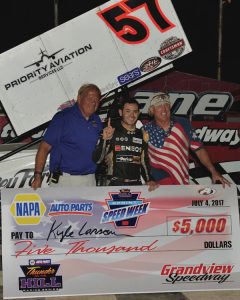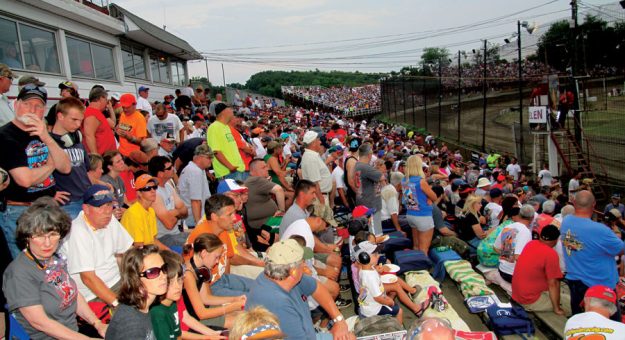The name is justified because to get to Grandview Speedway, one must climb a pretty steep hill. Upon arrival, one looks out at the rolling, verdant landscape of eastern Pennsylvania.
A high-banked clay saucer ringed by concrete walls, Grandview looks almost medieval in its presentation. At one’s elbows is the crowd, Pennsylvania people who could have stepped directly from the narrative of a John Updike or John O’Hara novel extolling their home state.
Grandview is a perfect melding of the simplistic and the spectacular. Its tight confines and towering banks guarantee that any race is going to be replete with knife-thrust, rock ’em, sock ’em action no matter what kind of race cars are involved. A typical race at Grandview is well attended, noisy and unfailingly wild.
Which is why the recent speculation that Grandview was going to be the latest speedway claimed by commercial development was stunning to those who know the track well.
The Rogers family, which scraped the top off a hill in Bechtelsville, Pa., to build the track in the early 1960s, announced publicly that it was evaluating a proposal by the auction giant Copart to turn the historic track in Washington Township, Berks County, into a place for staging junk vehicles for eventual liquidation. The deal ultimately fell through in late October.
Grandview spokesman Jeff Ahlum said Copart was withdrawing its application, and that racing would resume in 2023.
Grandview Speedway was spawned by the vision of the late Forrest Rogers, who was a longtime race fan and decided to build a track in 1963, in what was then a very rural area. Rogers had attended races at the Reading Fairgrounds and Hatfield Speedway, and originally wanted a half-mile track.
The land parcel turned out to be too small, so Rogers compromised by building a one-third-mile dirt oval with steeply banked corners. Whether he realized it at the time or not, Rogers succeeded in building a highly competitive track, the ideal length for open-cockpit machinery.
The crowds came quickly, and like the racers, most of them hailed from the towns and farm areas spread between Reading and Allentown. Forrest Rogers lived long enough to see his new track sprout successfully, Grandview’s control reverting to family matriarch Theresa Rogers, her husband, Bruce, and children, Kenny and Tina, when Forrest passed away around 1965.
Grandview settled at first into a two-division stock car show on Saturday nights, creating its first star, Warren Mutter, who claimed at least 30 wins during the 1960s in Grandview’s lead division, then called sportsman-modifieds.
The track’s reliance on small-block engines for its lead division, which remained a constant, resulted in a slightly less expensive program, good crowds and well-filled pit areas.

Grandview’s repertoire expanded significantly in the late 1960s when New Jersey midget owner Ed Darrell convinced the Rogers family to host open-cockpit programs on Sunday night.
These were hugely popular with events sanctioned by the American Racing Drivers Club, the Super Midget Racing Club and the United Racing Club among other organizations.
No discussion of Grandview would be complete without describing what happened later. The obvious aesthetic appeal of open-cockpit action at the tight facility and the success of the Darrell shows led independent Pennsylvania promoter Bob Miller to rent the track from the Rogers family and from 1990 forward, present a series of innovative midweek race programs known collectively as Thunder on the Hill.
Under Miller’s guidance, 140 Thunder shows have been run at Grandview.
They’ve been open to open-cockpit cars of all stripes — World of Outlaws, Southern California Racing Ass’n, All-Star Circuit of Champions and USAC — plus modifieds.
Grandview raced under NASCAR sanction for many years and was the linchpin of a Pennsylvania small-block modified circuit that also encompassed Big Diamond and Penn National speedways.
“I think the racing is what sells Grandview. It’s unbelievable,” Miller said. “I still get excited watching the races there. It’s just flat out, bumper to bumper, constantly in lapped traffic. I talked to Matt Sheppard, who won his first DIRTcar win at Grandview and I remember him telling me he didn’t know if he was on the backstretch or home straight by the time halfway through the race. It’s just around and around and around. And Bruce Rogers was as honest as the day was long.”
Grandview has produced stars throughout its existence, starting with Mutter, who was amassing the first of his 31 wins when track historian Vicki Gehris joined its staff in 1968, walking five miles from home with her mother to attend the races.
She chronicled the entire history of Grandview’s all-time feature winner, Craig Von Dohren, a 13-time champion who scored 123 modified wins, including a triumph in the most recent running of Grandview’s premier event, the Freedom 76, where he holds six victories. A kid from nearby Oley, Von Dohren embodied the type of local racer who made up the bulk of Grandview’s competitors during its history.
Two other local guys, Duane Howard and Jeff Strunk, are next on the all-time modified feature wins list. The ageless MeMe DeSantis owns 26 victories. Recently retired Tom Mayberry has 34. Among modified drivers from farther afield, Billy Pauch was a stout Grandview competitor with 22 feature wins, including six in the Freedom 76.
Another New Jersey driver, Chip Slocum, found victory lane 16 times at Grandview. Dave Kelly and Glenn Fitzcharles scored modified wins before achieving much greater success in sprint cars. Modern-day stars, including Tim Buckwalter and Stewart Friesen, both enjoy multiple wins at Grandview.
The open-cockpit rankings, compiled by publicity director Jeff Ahlum, are equally rich. In the midget ranks, the longtime veteran Leigh Earnshaw leads all drivers with 22 feature wins. Bob Cicconi won 20 times. George Ferguson Jr. owns 17 midget wins, trailed by Nick Fornoro Jr. with six.
Kelly leads all hands with 20 URC sprint car wins, trailed by Fitzcharles (eight), Kramer Williamson (six) and Charlie Massey and Josh Weller, each with four. Among non-winged sprint winners, representing both SCRA and USAC, Brady Bacon leads with five wins. Pauch, Levi Jones and Brian Clauson each have one, with Jesse Hockett holding a single victory.
In the world of 410 sprint cars, Pauch, Fred Rahmer, Lance Dewease and Greg Hodnett have nine wins each, trailed by Steve Kinser (five). Keith Kauffman and Kyle Larson have four 410 scores. World of Outlaws winners have included Sammy Swindell, Tim Shaffer, Danny Lasoski, Christopher Bell, Aaron Reutzel, Jac Haudenschild and Darren Pittman.
Two individuals have been fixtures at Grandview for much of its history. Now retired, Ernie Saxton spent 55 years at Grandview, duties that included announcing, public relations and advertising sales for the track program. His late wife, Marilyn, who was Darrell’s stepdaughter, also worked at the track.
“Nobody ever came up to me, as a driver or anything else, and said that Bruce Rogers made a promise to me and he didn’t keep it,” Saxton recalled. “Bruce made promises, he kept promises, and he was a good man to work with. First time I ever went to Grandview, I walked through the front gate and Bruce’s mother and her girlfriend were selling tickets off a kitchen table. But it was a great decision that I made; they left the door open for me to handle things as I see fit, and it turned out to be pretty successful. The Rogers family did an outstanding job.”
Saxton announced the rise of another Grandview stalwart, Fred Rahmer, whose Hall of Fame career began when he hammered his way to 45 modified wins at Grandview before switching to sprint cars and unrolling more than 400 feature triumphs, first among all Pennsylvania drivers. Rahmer got into racing after his father, Fred Sr., was a multiple stock car winner at Grandview.
The lessons taught by the little bullring made him a national star, Rahmer recalled.
“The way you had to race there really helped me out in whatever else I ended up doing, because you didn’t have to learn how to just drive fast, you had to learn how to do it in traffic,” Rahmer explained. “To this day, it’s still one of the best tracks in Pennsylvania as far as I’m concerned. Entertainment-value wise, there’s always good, tight racing and action all the time. And I always really liked Bruce and Theresa Rogers.
“It’s where I learned to race, any good or bad habit I picked up, I got there. I started 20th there every week, just about, and I was able to win some races. My dad, Fred, ran mostly Grandview and Mahoning Valley. Grandview might not present that well, but wow, do they put on racing. Something’s always happening.”
